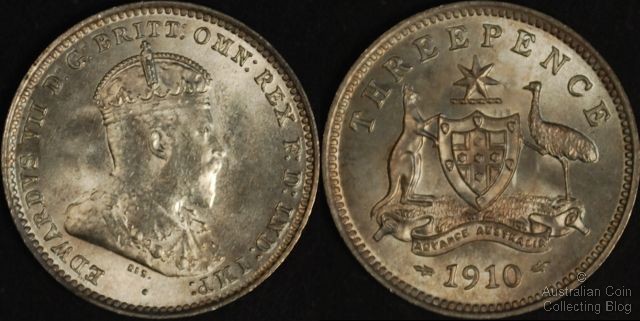
Australia 1910 Threepence
2010 marks the 100th anniversary since the first official silver coins minted for the country of Australia were released. At the time, the Australian government decided to adhere to the British Sterling standard and consequently threepence, sixpence, shilling and florins (two shillings) were minted in 92.5% silver. Before the coinage act of 1909 (which decreed Australia should have it's own coinage) the standard coinage in Australia was that of England. English coins had circulated in Australia since colonisation in 1788. Some coins were struck here in Australia prior to 1910 such as the holey dollar and dump and many different unofficial traders tokens usually struck in bronze. Some few tokens were also struck in silver but again these were not official coinage of the land.
These coins were dated 1910 and all carried the portrait of Edward VII on the obverse and the Australian Coat of Arms on the reverse. The portrait of King Edward VII was sculpted by George De Saulles. Interestingly this designer died in 1903, seven years before his designs were introduced onto currency. The reverse design was sculpted by WHJ Blakemore. None of the coins has a mintmark (which first appeared in 1914 when some silver coins were minted at the Heaton mint). No copper coins were struck dated 1910 but they did appear in Australia in 1911. The first silver coinage to arrive in Australia from the Royal Mint in London were shillings in March 1910. Edward VII died in May and the rest of the 1910 silver denominations followed into Australia after his death. 1910 is the only year to carry the portrait of Edward VII as 1911 coins bear the effigy of the new King George V. Coins were not minted in Australia until 1916.
None of the 1910 silver coinage is especially scarce with mintages being reasonably large. Mintages were 4 million for the 3d, just over 3 million for the 6d, 2.5 million for the shilling and the lowest of the series 1.2 million for the florin. As you'd expect the florin is the key to the date set with uncirculated examples very hard to find and worth in excess of $3,000. Uncirculated examples of the other denominations are not so hard to find, with uncirculated examples worth $250, $400, and $700 for the 3d, 6d, and 1s respectively. The Edward VII portrait is notoriously flat and can be very poorly struck up so when evaluating a coin of 1910 this should be taken into account. The coat of arms should be very well struck up on the reverse with full emu feathers, a clear Advance Australia and strong shields. One thing to be wary of with the 1910 coinage (and all older silver coins) is that they may have been rubbed lightly many years ago or suffered cabinet friction. The evidence of this may be well hidden by 90 years of toning so great care should be taken to examine the high points of the coin for such damage.
Posted by mnemtsas at November 30, 2009 12:21 PM
Subscribe to our Newsletter


